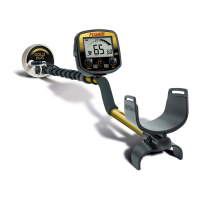8
29
QUICK-START DEMONSTRATION
HOT ROCKS
I. Supplies Needed
• a Nail • a Zinc Penny (dated after 1982)
• a Nickel • a Quarter
II. Position the Detector
a. Place the detector on a table,
with the searchcoil hanging over
the edge.
Or better, have a friend hold the
detector, with the searchcoil off
the ground.
b. Keep the searchcoil away from
walls, floors and metal objects.
c. Remove watches, rings and
jewelry.
d. Turn off lights or appliances,
whose electromagnetic emissions may cause interference.
e. Pivot the searchcoil back.
III. Click on detector with the left knob. Set the Gain at the
12:00 position for this demonstration.
IV. Click the right knob to the left to the DISC setting.
V. a. Wave the nail over the searchcoil.
b. Press
+
repeatedly, while continuing to wave the nail.
• Notice the change in sound.
• Sound changes from a HIGH tone to a LOW tone.
VI. Wave each object over the searchcoil.
Sweep coin flat and parallel to the searchcoil. This is how
you will usually find them buried.
a. Notice the tones and 2-digit target IDs for each object.
b. Motion is required.
Objects must be in motion over the searchcoil to be
detected in this mode.
VII. Press the
+
button several more times until the Disc value on the
display
=
60.
VIII. Wave the nail over the searchcoil.
a. The nail will not be detected
b. The nail has been “discriminated out.”
Quick-Start Demo continued on next page
A hot rock is a rock which causes the metal detector to sound off because the
rock contains iron minerals. They come in two basic types.
Negative hot rocks (also called cold rocks) are usually magnetite or
contain magnetite, and give a negative response because their ground
balance value is a higher number than the soil they are found in. They
tend to be dark in color, usually black, and usually heavy. In some cases
they will have rust stains. They are usually attracted to a magnet, and for
this reason gold prospectors always carry a magnet -- the ultimate
ferrous/nonferrous discriminator. In All Metal mode, negative hot rocks
produce a
boing sound rather than the zip sound of a metallic target;
recognize the difference and you will learn to ignore them. As the
searchcoil passes over a hot rock, this
boing sound, or negative response,
is quite distinctive. To hear this response, you must be properly Ground
Balanced and in All-Metal mode with an audible threshold hum. First, as
the center of the searchcoil passes over the negative hot rock, the
detector will go quite; the threshold hum momentarily silences. Then,
passing beyond the negative hot rock, you hear the
boing sound. As you
pass the searchcoil back and forth over a negative hot rock, it will be
impossible to pinpioint and will seem as if it
moves around.
Positive hot rocks are iron-bearing rocks which have been oxidized by
natural weathering processes so that their GRND BAL value is a number
lower than the soil they are found in. They are often small, right on the
surface, sound just like a gold nugget, and are common in many gold
prospecting areas. They are usually, but not always, drawn to a magnet.
They are most often reddish in color but are often black, brown, or yellow.
On relic hunting sites, red clay bricks and rocks which have lined a fireplace
or a campfire will often be
hot rocks. The discriminator will usually eliminate
them without difficulty if widely scattered, but if there is a large concentration
of them, the discriminator may not quiet them all. In that case, you can
revert to the rule of thumb -- “don’t dig non-repeatable signals.”
Remember to always carry a magnet to help discriminate gold from hot rocks
and iron.
• Gold will not
be attracted to a magnet.
• Pieces of iron will always
be attracted to a magnet.
• Negative hot rocks will almost always
be attracted to a magnet.
• Positive hot rocks will usually
be attracted to a magnet.

